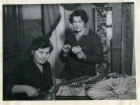Museum-Reserve “Pavlovsk”. Revived beauty
The Pavlovsk Palace and Park Ensemble was occupied by the fascists on September 17, 1941 and released during the battles for Leningrad on January 24, 1944. During the period of occupation by the Nazis in the park were cut down 70,000 trees, pavilions were destroyed, blown up bridges and dams, in January 1944 the palace was damaged by fire.
Since the beginning of the Great Patriotic War there was carried out the work on evacuation of museum collections in the rear, as well as the shelter of the palace and park sculpture located in the museum. Sculptures of the halls of the palace were walled up in one of the compartments of the basement, park sculpture was buried in wooden boxes near the same location.
Under the leadership of museum director A. I. Zelenova under unfinished military action was organized the work on the revival of the old image of Pavlovsk. The authors of the project of restoration of the palace were the architect F. F. Oleinik and S. V. Popova-Gunich. The works were carried out by the Leningrad organization "Fasadremstroy" led by chief O. O. Gendelman. Paintings are made by A. A. Treskin together with a group of artists on his sketches. Stucco works were conducted by Brigade of I. I. Kalugin, decorative sculpture recreated by N. I. Maltseva and T. P. Shabalkina.
In 1948-1949 in the park were planted about 65,000 trees, there were restored bridges, dams and pavilions. The Pavlovsk Palace has become the first suburban palace, restored after the Great Patriotic War. During the works, which were carried out over the architectural ensemble of Pavlovsk there was first developed a domestic scientific method of restoration of historical and architectural monuments. The period of the restoration work to restore interiors and landscapes of the palace and park complex, as well as the museum is depicted in photographs transmitted by the Pavlovsk Museum Reserve. In addition, the proposed collection includes a historical calendar, issued a by the Presidential Library on the basis of this material.
- The Pavlovsk Palace
- The facade of the palace and adjacent to the Palace territory
View of the Pavlovsk Palace. Helicopter shooting
View of the Pavlovsk Palace. Helicopter shooting. Pavlovsk, [20 -].The central building of the palace from the front parade ground
The central building of the palace from the front parade ground. Pavlovsk, 1946.The central building of the palace from the front parade ground. Side view
The central building of the palace from the front parade ground. Side view. Pavlovsk, 1944.The central building of the palace from the front parade ground
The central building of the palace from the front parade ground. Pavlovsk, 2006.The parade ground. Monument to Paul I
The parade ground. The monument to Paul I. Pavlovsk, [20 -].Pavlovsk Palace from the side of the river Slavyanka
Pavlovsk Palace from the side of the river Slavyanka. Pavlovsk, 1944.Pavlovsk Palace from the side of the river Slavyanka. Winter view
Pavlovsk Palace from the side of the river Slavyanka. Winter view. Pavlovsk, 2008.The Gonzaga Gallery
The Gonzaga Gallery. Pavlovsk, 1944.The Gonzaga Gallery
The Gonzaga Gallery. Pavlovsk, 2014.Park sculpture "Flying Mercury"
Park sculpture "Flying Mercury". Pavlovsk, 2008.Own garden
Own garden. Pavlovsk, 2011.Own garden. View of the Pavilion of Three Graces
Own garden. View of the pavilion of three graces. Pavlovsk, [20 -]. - The interior decoration of the palace
- Front halls
The Greek Hall. Panorama
The Greek Hall. Panorama. Pavlovsk, 2014.The Italian Hall. Panorama
The Italian Hall. Panorama. Pavlovsk, 2009.The Italian Hall. Sculpture and bas-reliefs
The Italian Hall. Sculpture and bas-reliefs. Pavlovsk, 2009.The throne room is destroyed. 1945
The throne room is destroyed. 1945. Pavlovsk, 1945.Throne room. Painting a plafond
Throne room. Painting a plafond. Pavlovsk, [20 -]. - State apartments of Empress Maria Feodorovna
M.F. Library
Library MF Pavlovsk, 1946.Library MF Panorama
Library MF Panorama. Pavlovsk, 2009.Boudoir M.F.
Buduar MF Pavlovsk, 2008.The main bedroom. Panorama
The main bedroom. Panorama. Pavlovsk, 2009.
- The Pavlovsk Park
Large circles
Big circles. Pavlovsk, 2009.View of the Italian staircase
View of the Italian staircase. Pavlovsk, 2008.Pond in front of the Volier
Pond in front of the Volier. Pavlovsk, 2014.Statue of a Muse with Twelve Paths
Statue of a muse with Twelve paths. Pavlovsk, 2008. - Restoration works
Extraction of sculpture in the Egyptian vestibule
Extraction of sculpture in the Egyptian vestibule. Pavlovsk, 1944.Opening of burials of palace sculpture in the basement of the palace
Opening burials of the palace sculpture in the basement of the palace. Pavlovsk, 1946.Palace sculpture
Palace sculpture. Pavlovsk, 1946.Filling the pits from the dugouts between the Krasnodolinna and the Botanical Alleys
Filling the pits from the dugouts between the Krasnodolinaya and the Botanical Alleys. Pavlovsk, 1946.Planting trees in the Big Star
Planting trees in the Big Star. Pavlovsk, 1948.Group of hackers
Group of sculptors. Pavlovsk, 1955.Group of restorers A. V. Treskin
Group of restorers A. V. Treskin. Pavlovsk, 1957.Gilded AI Ivanova
The gilded Ivan Ivanov. Pavlovsk, 1966.Restorers of fabrics TA Berlin and AF Kirillova
Restorers of fabrics TA Berlin and AF Kirillova. Pavlovsk, 1967.Pavlovsk. Revived Beauty
Pavlovsk. Restored beauty.





































